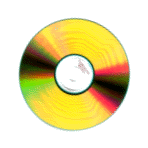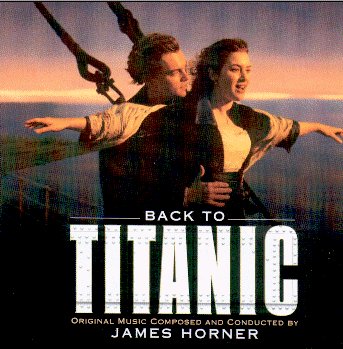Music Webmaster Len Mullenger |
||
Music Webmaster Len Mullenger |
||
 |
FILM MUSIC RECORDINGS REVIEWS |
 |
October 1998
| Discs on these pages are offered for sale. There is also a page of search engines from a selection of on-line retailers here. Please support this web-site |
James HORNER
Back to Titanic  Original
music composed and conducted by James Horner Original
music composed and conducted by James Horner  SONY SK 60691 [79:07]
SONY SK 60691 [79:07] |
|
|

Timed adroitly to coincide with the video release of the film, this new CD
includes some material not included in the highly successful original CD
which, according to Sony Classical, has sold nearly 25 million copies world-wide.
(The home video was released in America on September 1st with pre-orders,
there, totalling in excess of 22 million copies. Sony Classical coyly, are
not commenting about anticipated sales of this Back to Titanic CD,
except to say that they are hoping to sell at least 3 million).
So is this new album worth considering? The opening track is what Horner calls his Titanic Suite which is in one continuous 19 minute movement. Like the final Epilogue - The Deep and Timeless Sea, which closes the album, it is performed by the London Symphony Orchestra with choristers from King's College, Cambridge. In the main it is a relatively quiet elegy. Horner omits the more dramatic music associated with the collision with the iceberg and its immediate aftermath. His orchestra includes 22 violas, rather than the normal six to eight, to give an impressive depth to his sea pictures. (Listening to this music under headphones I was very conscious of the effect of a large top to bottom watery expanse - which I assume is what Horner was striving for?) The Suite opens quietly and mystically with a long held chord from the choir followed by slow moving string chords suggesting a serene seascape with only a slight swell. The music proceeds to include developments of the more sentimental material from the original Titanic recording but Horner also includes new material and his textures are richer and the orchestrations are even more imaginative. The mood of quiet melancholy and sad remembrance is interrupted for more jubilant and celebratory music associated with the early scenes at Southampton when the great ship sails majestically out into the Atlantic Then there is a brief but moving "Requiem" for brass choirs which is one of the highlights of this composition. Augmenting the Choir's voices is the wordless intonation of the Norwegian singer Sissel. But the whole is, for me spoilt, by the rather tasteless inclusion of the uillean pipes (yes, I know they have the require Irish associations and give the supposed timeless quality requested by the director) for they are recorded with some ugly glissandi and recorded too close (how much more effective this instrument might have been had it been placed further back to give a more "ghostly" - other-worldly effect). It should be said, though, that the Suite's nineteen minutes never drags which is a testimony in itself. I would respectfully suggest that Mr Horner considers eliminating everything except the choir and orchestra and combining the music of the first and last tracks and giving the choir some more interesting material, then, who knows he might have the beginnings of a Titanic symphony?
I should add that the Epilogue follows a similar pattern to the Suite. The opening pages and closing pages, are impressive seascape evocations, but one feels that Horner is too much in love with his creation and that some judicious editing would not have been amiss especially about three quarters through when the music becomes tediously repetitive.
Another "symphonic" cue is "A Building Panic" (omitted from the first album?) which is much more tense and dramatic. It successfully juxtapositions Irish dance rhythms against pounding rhythms as the sea crashes into the steerage cabins and claims the luckless poorer passengers locked therein.
For the rest, there are the Irish jigs and reels played during the party in the ship's third class section featuring Riverdance fiddler, Eileen Ivers who also plays the solo "Nearer My God to Thee"; there is the original-style "Alexander's Ragtime Band" played by I Salonisti for the better heeled passengers and Irish vocalist Máire Brennan sings the darkly ironic song "Come Josephine in My Flying Machine" which was popular at the time of the Titanic's sailing. But what will probably sell this album more than any other factor is once again Celine Dion singing "My Heart Will Go On", this time with added dialogue from the film (the second excerpt about the portrait, taken out of context, is in rather dubious taste and ruins the strived-for romantic effect)
As I write this review news has come from America that due to a lack of ticket sales, James Horner's "Back to Titanic" LA concert at the Hollywood Bowl has been cancelled. Public taste is indeed fickle and unpredictable. Perhaps you can have too much of a good thing?
![]()
Ian Lace
And a second view from Rob Barnett
Here are a few remarks to put my comments in context. I have not seen the film Titanic. I have heard the first soundtrack disc once.
The first track on this well-filled CD is Horner's Titanic Suite. This is an orchestral sequence with the haunting theme warmly presented. The lovely melting in and out of uillean pipes, vocalising soprano and Irish penny whistle is very affecting. The score is heavily influenced by New Age Celtic music typically represented by Enya and the more lyrical elements of the score for Riverdance. It is about time that Irish music escaped the pub ballads and looked mistily into Celtic landscapes and the land of the ever young. The 19 minute orchestral suite comprised in track 1 is very much in the spirit of the first Titanic disc and includes music which could not be fitted on the first disc. That said there is perhaps very little in the suite which you have not heard in one form or another on that first disc.
The Irish Party in the Third Class is a wild dance complete with what sounds very like dialogue from the OST. Alexander's RagTime Band is a palm court arrangement such as might have been heard aboard the doomed boat. The solo piano track entitled The Portrait is played by Horner himself. It is a lyric fantasy on themes from the score. Jack Dawson's Luck is an Irish gallimaufrey for a droning bass, pipes, fiddle and drums swooningly yearning and audacious. For those who do not know let me also recommend the Rita Connolly CD of Shaun Davey's Granuaile - well worth getting if you like this wild Celtic lyricism. This track is extremely effective as is Horner's piano solo.
A Building Panic is a stormy track which takes us back to the sound of the first album - instrumental-orchestral with a trace of synthesiser. It is rather Sibelian (Tapiola) and none the worse for that. Nearer my God to Thee again transports us to the original liner band and a credible simple treatment of the Moody and Sankey style hymn which plays out to the sound of screams and the nemesis of the liner. Maire Brennan breathes and whispers and sings Come Josephine in my Flying Machine. There is then a ghostly funeral oration for solo violin and pipes and wind.
The astounding Celine Dion is heard in great voice in My Heart Will Go On and all the better for being in context with some original dialogue. I have to say though that this wonderful song owes a great deal to Carly Simon (a great Original) and her work on Coming Around Again. What a track and what a moment! There is one utterly crass episode when Dion is pathetically echoed by a chorus ("why does the heart go on?) - a horrid but momentary blemish in an otherwise devastating performance.
A Shore Never Reached returns to the orchestral tissue with much nobility sounding like an echo of the more exultant sections of Stravinsky's Firebird. Eileen Ivers who made a great name with her work on Riverdance plays a solo violin lament Nearer My God with affecting tenderness. Here is just the right level of hesitation and a catch in the throat. The orchestral Epilogue (12 mins) sweeps us back to the sea - deep and timeless.
The insert is a single sheet folded four times. The reverse of the sheet is fully occupied with a still from the film. This is the same approach as the Ryko series and I hope it is not a trend: multi-folded paper just will not survive. In years to come while CDs may continue untouched by passing time the complete product with an original and unbroken jewel case and a perfect insert will be major finds for collectors.
Overall this is a recommended album which in view of its variety and the glowing segments of dialogue is preferable in my view to the original album.
© Robert Barnett
![]()
Return to October Film Music Reviews